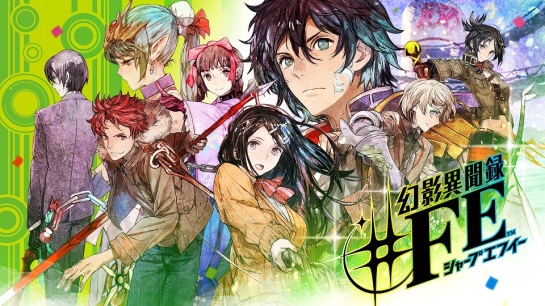
Shin Megami Tensei X Fire Emblem, like people still like to call it, has been the object of much anticipation in 3 years. Ending up quite different that most people thought when re-announced in April 2015, Tokyo Mirage Sessions #FE has the difficult task to seduce a reticent audience. Symbol of a sinking line-up as it sld only 30K units at launch in Japan, Atlus’s cross-over couldn’t find its way to success at home. Were the Japanese too hard on this game?
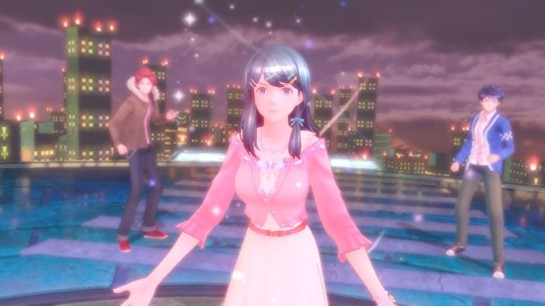
Tokyo Mirage Sessions #FE had the choice between Shin Megami Tensei’s darkness and Fire Emblem’s epicness. Atlus picked neither of them : the general atmosphere of this cross-over is light, extravagant and keeps away from anything serious. The theme of the game partially explains this, since the party members are all part of an idol agency. Tokyo is into trouble, attacked by Mirages, evil ghosts seeking to swallow people’s soul (here called performa). Of course, all your stars have special powers to defend the metropolis : they also act as Mirage Masters, warriors that borrow the power of benevolent Mirages to fight the bad ones. Add the race to stop an ancient demon from rising back, and you have in a nutshell the story of this game, which is rather straight and classic without much refinement.
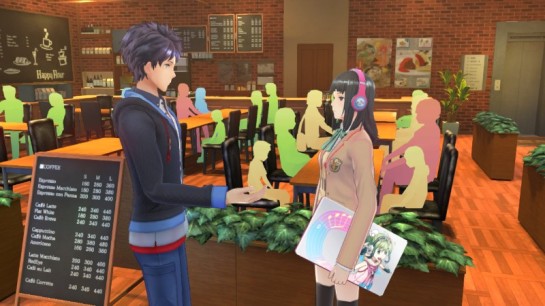
True, the game never insists on the story, as it prefers to go into the various aspects of Japan’s pop culture. Singing, concerts, TV shows, cinema, photography of young girls wearing swimsuits (but not in your version, sorry)… nothing has been spared to please the otakus. But in doing this, it is extremely since it successfully captures the life of the young, going as far as including several brilliant Hatsune Miku easter eggs. For example, your mage Kiria turns into some sort of adult Miku when wearing her combat outfit! Besides, there is an extensive side-story about a vocal synthesis soft much like vocaloid, with many clever details about the phenomenon. But because of all those these diversions, the storyline collapses quickly : the chain of events doesn’t make sense, or gets contradictory at times. Tokyo Mirage Sessions #FE is this game that throws a joke about the first kiss just before a major boss fight. Yes, it did that. The game’s narrative is actually just as ridiculous as Xenobalde Chronicles X’s but as Atlus’s title never pretended to be serious to begin with, it doesn’t look as bad as Monolith’s awkward JRPG, which was convinced to tell something epic but failed miserably.
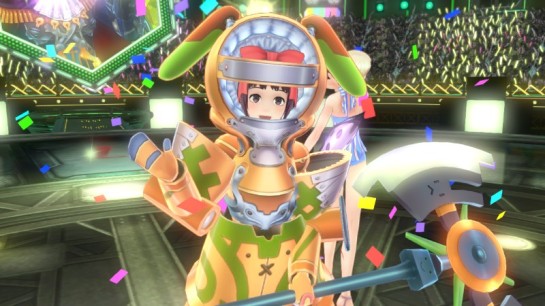
Still, that feeble narrative doesn’t really impact the experience, because Tokyo Mirage Sessions #FE focuses on its characters first. To fit with Japan’s crazy pop culture, Atlus has created offbeat protagonists, but with a rich background and a developed personality. In short, totally the contrary of its competitor on WiiU. Whichever character you consider, might it be Tsubabsa the naive rookie idol, Kiria the veteran singer who has a soft spot for kawaii stuff, Eli the half-American girl who says “Hollywood” in every sentence, Barry the gaijin dance teacher speaking with an atrocious accent, all have a wacky but deliciously hilarious behaviour.
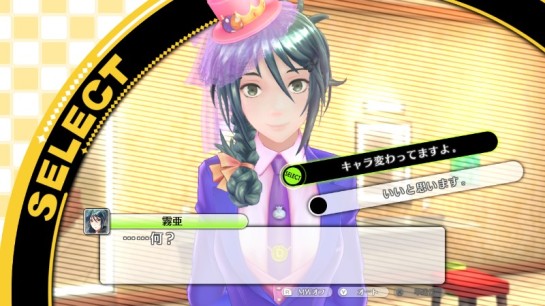
The game will go full force on that with a flurry of secondary quests/events that perfectly underline the eccentric charm of the characters, light-years from Xenoblade Chronicles X’s tedious kizuna quests. Not only are those sequences entertaining, but they are also lucrative because you’ll earn powerful skills, musics and cutscenes. The main protagonist Itsuki turns out to be the least charismatic, but it’s normal in a game like this where the secondary characters are the real stars. Poor Itsuki will be given a hard time by Eli and find it difficult to motivate Tsubasa who lacks self-confidence. Characters very opposed in style, but all side stories feel rich and have a nice ending.
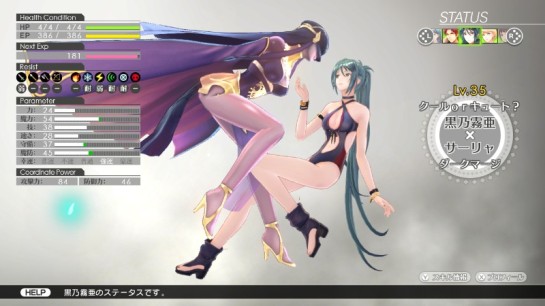
In the same aspect, let’s stress that the Mirages that lend their strength to the heroes are all Fire Emblem characters taken from various episodes. Clearly Intelligent Systems’s series was not forgotten by the developers. Their personalities have been faithfully transcribed, like the Tharja’s sadist tendency. She and Kiria make a fantastic and fun couple!
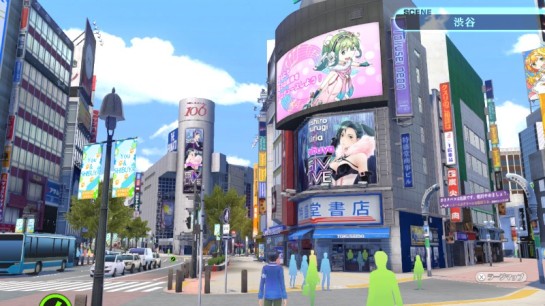
But the real problem of Tokyo Mirage Sessions #FE is its world. Far from being as immense as Xenoblade Chronicles X, the Tokyo of this cross-over is only composed of a couple of street, some areas being limited to one single room! Needless to say, there is little to explore with such a minimal surface. NPCs will never ask more than going to the adjacent street to pick something on the pavement. On the other hand, the decoration that changes depending on the various shows your characters are part of is nice.
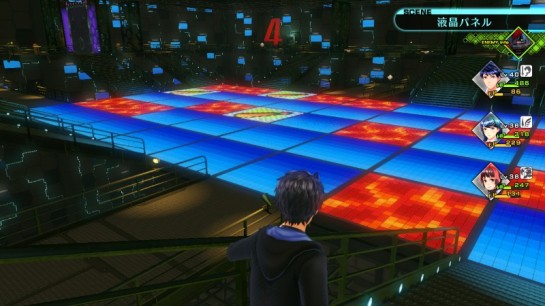
Therefore, you’ll spend most of your time in dungeons (Idraspheres as the game calls them). Far-fetched by their architecture, those ones will have think a little to solve some puzzle in order to advance : rooms to enter in a special order, buttons to change the stage layout or the good old platform floating in the sky. Mirages will regularly appear to trigger random fights, but it’s easy to stun them before that and avoid the encounter. In the same idea, you can save anytime even in a dungeon and are able to go back to the agency whenever you like. You can then play at your pace, without stress. In terms of sequence, it’s gonna be always the same thing which is rescuing an NPC whose wind has been highjacked by a Mirage, nothing more. All those dungeons plus the character events make Tokyo Mirage Sessions #FE’s adventure fairly long, way more than the 30 hours announced.
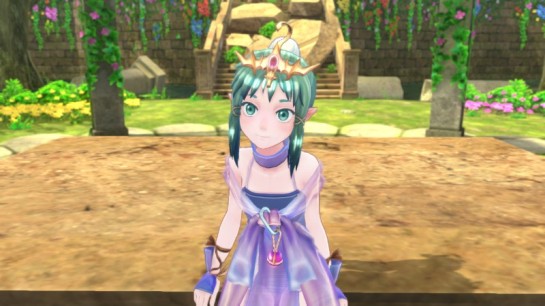
Before entering the fray, you need to be well prepared. For this, the agency has set a space outside the real world where young Chiki (yes, that Chiki, but considerably younger) will offer you various services. You’ll be able to synthesize new weapons provided you looted the needed items, improve the existing ones and later in the game, have your Mirages change class like they would do in Fire Emblem. By acquiring experience with a weapon, characters will learn three types of skills : active skills (magic, physical attack, support spells), passives skills (stats up or tactical advantages) and session skills (see below). There are a lot of these capacities so you’ll end up giving up and some because the slots are limited. Still, the array of possibilities is extremely rich and allows you to build your characters to fit your playstyle and your strategy. That’s were improving the weapons is key, because a skill can be upgraded when you learn it multiple times. Last but not least, Chiki can also synthesize new performas, that often bear capacities crucial to turn the tides in combat.
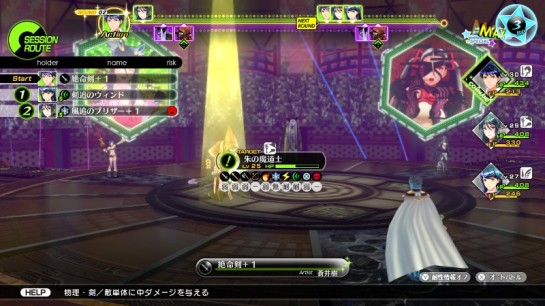
Let’s go in the heart of the battle. But first of all, let’s point out the remarkable presentation of the fights : they place like a performance, under giant screens showing the mood of the characters. Once again, Tokyo Mirage Sessions #FE follows its own original logic with brilliant details. In terms of battle system, Atlus borrows Fire Emblem’s triangle of weapons, as many enemy Mirages are affiliated with a weapon category (or others like Dragon, Amor and Knight). Up to the player to find the right attack to deal maximum damage, this being true for natural elements (fire, lightning, etc) also.
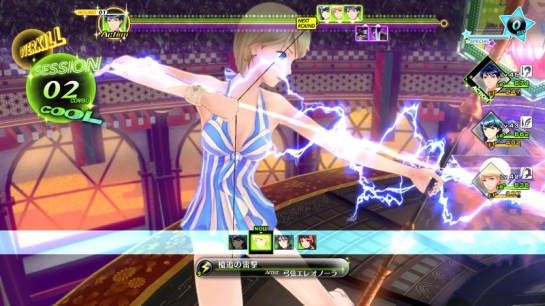
But the monsters in Tokyo Mirage Sessions #FE are seriously tough and can’t be beaten in 1 or 2 blows. Here you use what are called “sessions”. It’s very simple : every time a character strikes in the enemy’s weak spot, allies will also strike just after him without consuming any turn! That mechanic implies that your characters have several session skills, which allow him to act after a certain type of weapon or magic. So, the more our characters progress, more can take part in session and more powerful and long those sessions become. Note that the session can fail if you hit the resistance of an enemy : you must therefore anticipate the effects by checking the session list (which is displayed).
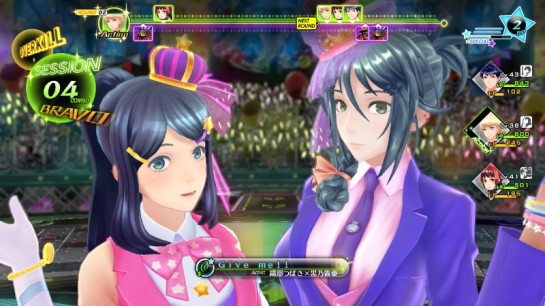
At higher level, you’ll have the possibility to extend the sessions. You need to acquire duo skills which are exclusive to character sidequests. As you can expect, those duo skills are all about singing and performing. They are still extremely powerful, dealing enormous damage and having support effects like healing. The music of the game is highlighted it those duo skills, and feature really good J-pop. The rhythm in Give Me or Black Rain as quite pleasant, and the associated clips beyond greatness (see below). Combat themes have a more dark tone, but are good too, like the fantastic boss battle theme n°2.
You will need to master all that, because this Atlus-made game is far from easy. Although it’s still possible to change the difficulty settings anytime, the normal mode is a formidable challenge : bosses have no mercy, battles necessitate to keep its cool but yet the progression curb is perfect. In other terms, Tokyo Mirage Sessions #FE brings the joy of a complex and challenging JRPG while keeping adequate balance. Something quite rare nowdays.
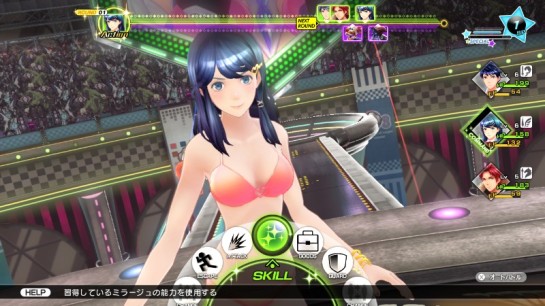
In pure graphics, nothing very impressive in Atlus’s work. The dialog phases look like early PS3 era at best. The city isn’t very pretty, dungeons have simplistic design and damn, NPCs are made of… cardboard! Fortunately, battles are a lot more beautiful, featuring modeling and animation a lot above the rest of the game. They’re full of little funny gestures that make them astonishingly lively. Let’s also point out the numerous additional costumes in-game, although I can’t tell if they survived Nintendo’s censoring frenzy…
Lovable characters, great sense of humor, enjoyable atmosphere, exciting fighting… but tiny world, Tokyo Mirage Sessions #FE is the complete opposite of Xenoblade Chronicles X. While conservative Nintendo fans might be thunderstruck at the sight of its rosy and otaku universe, it’s definitely a solid JRPG with deep mechanics. Maybe not the Shin Megami Tensei X Fire Emblem you were expecting, but what it does, it does it well.
